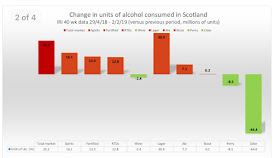Just watch this garbage...
Alcohol sales fall in Scotland after price increases: Extend this to other parts to the UK?
Conservative MP Tobias Ellwood: “Absolutely I would, yes”
SNP MP Alyn Smith: “Problem drinking on the way down” #politicslive https://t.co/nUNEVeztGB pic.twitter.com/ERSRRxJ1DV— BBC Politics (@BBCPolitics) January 28, 2020
So much nonsense in so little time.
Firstly, there's been no research published on problem drinking in Scotland under MUP, so Smith is a fabulist to claim that it is 'on the way down'. All we have are the alcohol-related death figures for 2018 which rose in Scotland and fell in England and Wales (although you'd never guess that if you relied on the BBC for your news.)
Secondly, Scotland's alcohol consumption is not "average" for the UK, as Smith claims. It is significantly higher and has been for as long as anyone can remember.
Thirdly, Mexico has never had minimum pricing. I can only assume that Jo Coburn is confusing it with another regressive nanny state policy, the sugar tax.
In case you're wondering, the fourth guest was also in favour of minimum pricing. Lovely bit of balance.
As for the report itself, it claims that there was a 3.6 per cent drop in off-trade alcohol sales in the twelve months after MUP was introduced. This, apparently, is what success looks like...
A 3.6% decline is a very different finding to that produced by the IRI sales figures that I have mentioned before.
IRI's figures show that there were 25 million more units of alcohol sold in the first nine months of minimum pricing than in the same period in the previous year. This is not a large rise, but it is certainly not a decline, even when you look at the figures on a per capita basis. Although I haven't seen the figures for the last three months of the year, I am told that nothing dramatic happened to sales that would have reversed this picture. (UPDATE: I've now seen the full year's figures and sales were slightly higher than in the previous year.)
IRI uses a similar methodology to Nielsen in so far as they both look at what goes through the tills in a large sample of shops. Aldi and Lidl don't co-operate with either company so IRI and Nielsen have to estimate/guess how much alcohol they are selling. This leaves room for error in both sets of statistics and I cannot say which has the best system.
Nielsen gets data directly from 83% of the non-discount supermarkets and large convenience chains, of which there are over 10,000. But for the 33,000 independent convenience stores, it settles for a weekly random sample from which it makes an estimate.
That's a problem because there is good evidence that people are shopping more alcohol in convenience stores since MUP was introduced. Why wouldn't they? If supermarkets don't have a price advantage on cheap drink, you can just buy it from your corner shop.
It is unclear whether the discount supermarkets Aldi and Lidl have benefited from MUP, but we do know that people are using them more year-on-year for their grocery shopping. Therefore, the two sectors of the retail industry that are most likely to have been selling more alcohol since May 2018 have the least reliable information in the Nielsen data set.
I'm not saying it's necessarily wrong, nor am I saying that the IRI figures are necessarily better. It would obviously not be surprising if a price rise led to less consumption. Unless the alcohol industry publishes the IRI figures, people are naturally going to rely on the Nielsen figures. But the overall sales figures published today are far from definitive and may be way off.
And when you consider the cross-border and online shopping that has undoubtedly taken place - but which cannot be quantified - you should not mistake any sales figures for consumption figures.



No comments:
Post a Comment
Comments are only moderated after 14 days.